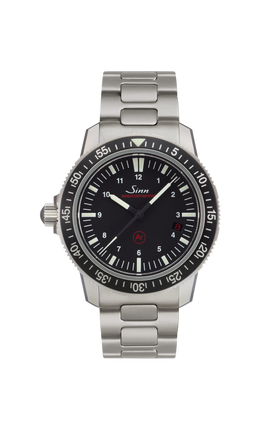Accuracy of the watch
This Sinn trademark identifies watches featuring magnetic field protection of up to 100 mT (= 80,000 A/m). It portrays stylised magnetic field lines and a magnetic core.
Magnetic fields such as those of electric motors, loudspeakers or door closers cause the Nivarox balance spring to become magnetised and adversely affect the accuracy of the watch. We solve this problem by using a protective sheath consisting of a closed, magnetically soft inner case that includes the dial, the movement holding ring and the case back. This Magnetic Field Protection minimises magnetic interference.
Interference of the accuracy of the watch due to magnetic fields
As early as the 1930s, watches used for special purposes were protected against magnetic fields. The electric motors of locomotives considerably interfered with the accuracy of mechanical watches. An iron shield was therefore used to protect special “railway models” from magnetic field interference. Later, Magnetic Field Protection was integrated in pilot watches due to the magnetic deflectors used in the radar screens found in airplane cockpits and ground stations. However, the restriction of Magnetic Field Protection to professionally used chronometers is proving absolute in today’s world. While the earth’s magnetic field is far too weak to pose any risk, magnetic fields from electric motors, loudspeakers, door closers or other such sources can cause lasting interference with the function of a mechanical watch.
The main source of defect
Nivarox balance springs are made of a temperature-compensating material which, in certain unfavourable circumstances, becomes magnetised. Irregularities in the rate of the movement are therefore the result of a magnetised balance spring, i.e. a defect in the watch’s clock-pulse generator.When it comes to magnetic field sensitivity, the modern balance spring is far superior to the older steel springs with regard to sensitivity to magnetic fields, because Nivarox springs are non-magnetic as required by DIN 8309. However, in the case of a relatively low magnetic field exposure of 6 mT or 4,800 A/m – roughly one quarter of the pole strength of a common household magnet – this permits an accuracy error of ±30 seconds per day. Compliance with chronometer standards is thus impossible. If the spring is exposed to stronger magnetic fields, the oscillation of the balance will change permanently.
Conversion table
| Unit | SINN watches with Magnetic Field Protection |
mT (millitesla) A/m (ampere per metre) Gauss | 100 80.000 1.000 |
Conversion table showing the common measurement units for magnetic fields.
Magnetic Field Protection
Magnetic fields can be diverted using magnetisable materials. Place a hollow body of iron in a magnetic field and you will see that a large part of the magnetic flux lines are bundled in the wall of the hollow body. The interior is thus shielded to a large extent from magnetic forces. SINN engineers use this principle to their advantage to create Magnetic Field Protection. Following exposure to a magnetic field, it is important that the protective sheath does not remain magnetised and thus become a source of interference.Materials that can be easily magnetised yet have little remanence (residual magnetisation after exposure to a magnetic field) are referred to as “magnetically soft”. Pure iron is a very good example of this.
With the aid of magnetically soft materials, Magnetic Field Protection up to 100 mT or 80,000 A/m is achieved for our watches in the event of typical everyday unipolar contact. In order to produce this Magnetic Field Protection, we use a closed, magnetically soft case interior that includes the dial, the movement holding ring and the case back.

Unipolar contact between watch and magnet.

In a study of 1,000 watches by SINN’s customer service department, nearly 60% of the watches received were magnetised, and half of these had severe defects caused by magnetic fields. During this study, the accuracy of the movement before and after demagnetisation was documented. If the speed deviation before demagnetisation was greater than 5% of the speed after demagnetisation, a defect due to magnetic fields was assumed. Magnetic field influences were also found even when the wearers weren’t aware of any contact with sources of magnetic fields. As a consequence, all watches received by our customer service workshop are first demagnetised using an electromagnet.









